It is always exciting to solve a mystery that you have been working on for years. So it was recently with this question: who was the sculptor of one of Green-Wood’s most interesting sculptures, the Romaine family bronze, what I usually refer to as “The Exhausted Angel?” Years ago, in searching the surface of this wonderful piece, looking for a sculptor’s signature, I discovered what looked to me like one. But, try as I might, using several techniques, including manipulating photographs of it in a photo editing program, I could not begin to figure out what it said.
That all changed just a few weeks ago—and quite by chance. Courtesy of a little bit of rain. In preparing for Green-Wood’s annual Open Doors Tour—which I have been organizing since 2006—it occurred to me that, because we had had so many volunteers step up to help this year, we would be able to add some stops at gravesites along the route in order to share with visitors some of the less-frequently seen, but fascinating stories, at Green-Wood. One of those that I decided to add to the offerings was The Exhausted Angel:

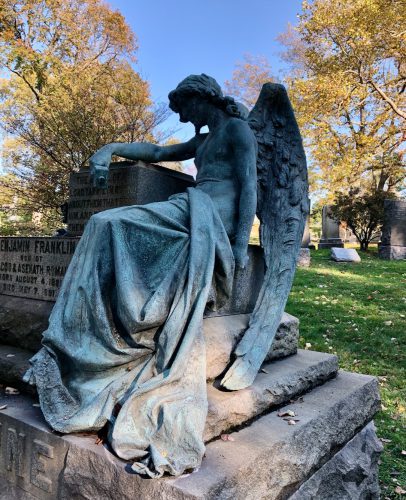
This bronze sculpture has long impressed me–for the beauty of its folds, the sweep of its wings, and the rather peculiar depiction of a sculptor/angel in a cemetery–certainly not as common a symbol as an obelisk, urn, or shroud. Why would this be?
My plan for Open Doors was to have a volunteer stationed along nearby Sycamore Avenue, pointing out this bronze, visible at a distance of about 50 feet, and explaining that try as we might we had been unable to figure out the sculptor’s signature. The volunteer, holding an 8 x 10″ photograph of the cryptic signature, would invite visitors to take a closer look to see if they might help us figure the inscription out.

In preparation for the tour, I needed to take a photograph of the signature, print it for the volunteer, and have her share it with visitors, asking if anyone could decipher what is said. So, a week or so before the Open Doors Tour, I went out to get that photograph. It had been drizzling a bit that morning, and as I positioned myself to capture the image, much to my surprise it seemed to me that I could see it more clearly, with the water on it, than I had ever seen it before. I could actually make out a few letters. This was exciting!
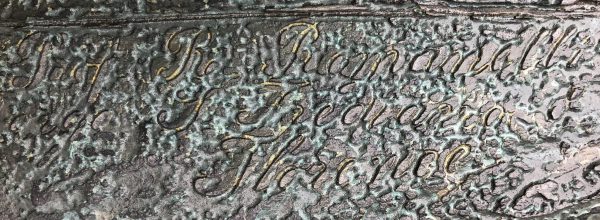
I took a variety of photographs—looking straight down from above, at a low angle, and much in between. I then examined them on my laptop and started to think that I could make out a name. Carefully looking them over, I began to think that I could read “Romanelli” and “Florence.” Now I was getting somewhere! So I searched the Internet for that combination—and lo and behold up popped a website of a sculpture studio in Florence, Italy, describing generations of Romanelli sculptors there:
Unfortunately, Mo Shockey, the volunteer who I had assigned to the Romaine Angel at Open Doors, and was very much looking forward to telling this tale, had to cancel. I did not have a volunteer to replace her–so this angel did not wind up a part of that event. However, before she cancelled, we excitedly exchanged emails on this discovery. After I shared my initial findings, Mo did some research and “found a very similar angel on the tomb of Romanelli’s father, with the backswept wing and all!”
Though I am a cemetery historian, and do love visiting cemeteries, I must admit that, on two extended trips to Italy, visiting mostly Rome, Florence, and Venice, I have only spent a good deal of time in one cemetery–the one on the hill above Florence–the Cimitere delle Porte Sante. I have been to Florence twice–and both times I visited that amazing cemetery. High above the city, across the river from the heart of Florence, it is not to be missed. As I looked at the photograph that Mo had sent me, I thought that the building in the background looked familiar. Quickly checking my photographs from my 2014 visit to Florence, I found this:
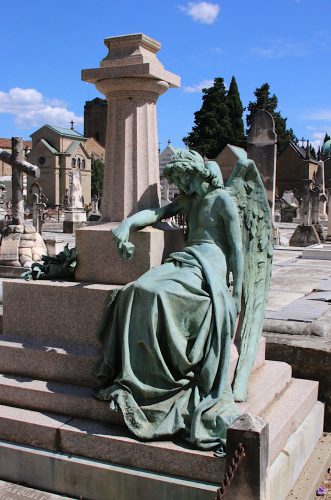
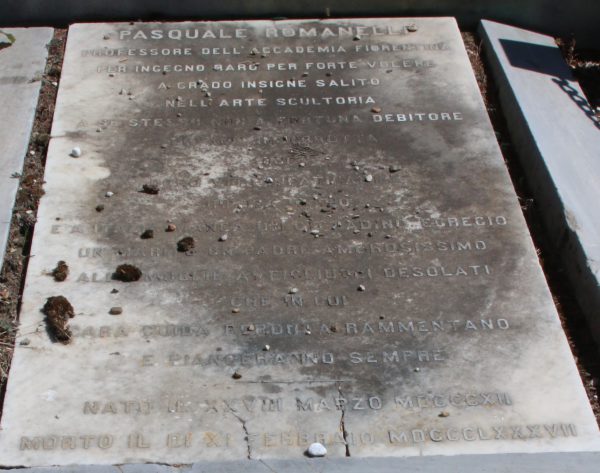
So, in fact I had been sufficiently impressed with this memorial in Florence–at the Cimitere delle Porte Sante–that I had take several photographs of it. That building in the background, which I recognized in the photograph Mo sent me, is the Basilica of San Miniato al Monte–also quite memorable. I must admit, when I photographed this wonderful angel in Florence, it had not occurred to me that it was the same as–and the source for–the Romaine Angel at Green-Wood.
Returning to the inscription on the Romaine Angel, I have puzzled it out, and I think it is this:
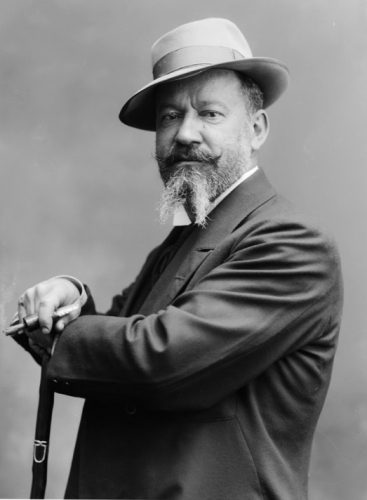
Another great research job. Keep it up.
Wonderful story, history on the one and only R. ROMANELLI. Being a sculptor, especially appreciate the connection to the Florence Academy oof Art. Amazing!
Wonderful story! it is amazing the connections that can be made with the right circumstances. Research and persistence paid off.thanks for sharing.
What a great story! This is my favorite angel at Green-Wood! The wings are so expressive and the angel so exhausted or dejected. Thanks for the background on the sculptor and the original sculpture!
I’m so impressed and happy to read this – I can’t wait until I can travel again – Florence is so much fun anyway – now I have yet another reason to visit.
That’s so cool, I love this detective work and the serendipity of having photos of the original angel already in hand!
Oh that ending is so fantastic!!! What a small world <3
Thank you for all your hard work, Jeff!!
Great work. Do you know anything about the Romaine family and in particular, Benjamin Franklin Romaine?
As per the 1863 Draft Registration records for Somerset, New Jersey, he was a clergyman.
Could there be a family connection between Romaine and Romanelli? Many people anglicized their names to seem more American, so maybe the Romaine family was originally Romanelli?
That is a very interesting possibility. I don’t know the answer–but if I have some free time in the not too distant future . . .
I agree with you. I wonder if this person was a relation of the Romanelli family, trained as a sculptor in the family business. The angel is holding the same tools as the sculptor’s grave angel in Florence. The next mystery to be solved!!!
I was so pleased to find out the name of the sculptor of the Exhausted Angel He is on the cover of my photography book on
Greenwood cemetery.
I stumbled upon (and photographed) this sculpture back in April during a solitary walk to alleviate Covid-induced cabin fever. It seemed to capture the feeling of the moment, and have returned to it since. Thanks for the background history Jeff – so happy to know more about this!
Thank you Jeff for bringing these great Green-Wood stories to light and sharing them with the world. Your dedication to uncovering the thousands of stories that make the cemetery a cultural and historical gem is greatly appreciated and will ensure that the cemetery will always be valued and cared for.
A great story and awesome sculpture. So very nice to read. Thanks for sharing.
Glad you enjoyed it!
This is so cool that you found this. Thank you so much.
Many years ago, during a discussion of a Civil War battlefield, someone made a comparison between a “history buff” and a historian, saying that the historian is someone who adds something of value to the history (of whatever they’re studying). It looks like you do that frequently. Thank you for adding to the fascinating history of Green-Wood!
Thanks! Very nice of you.